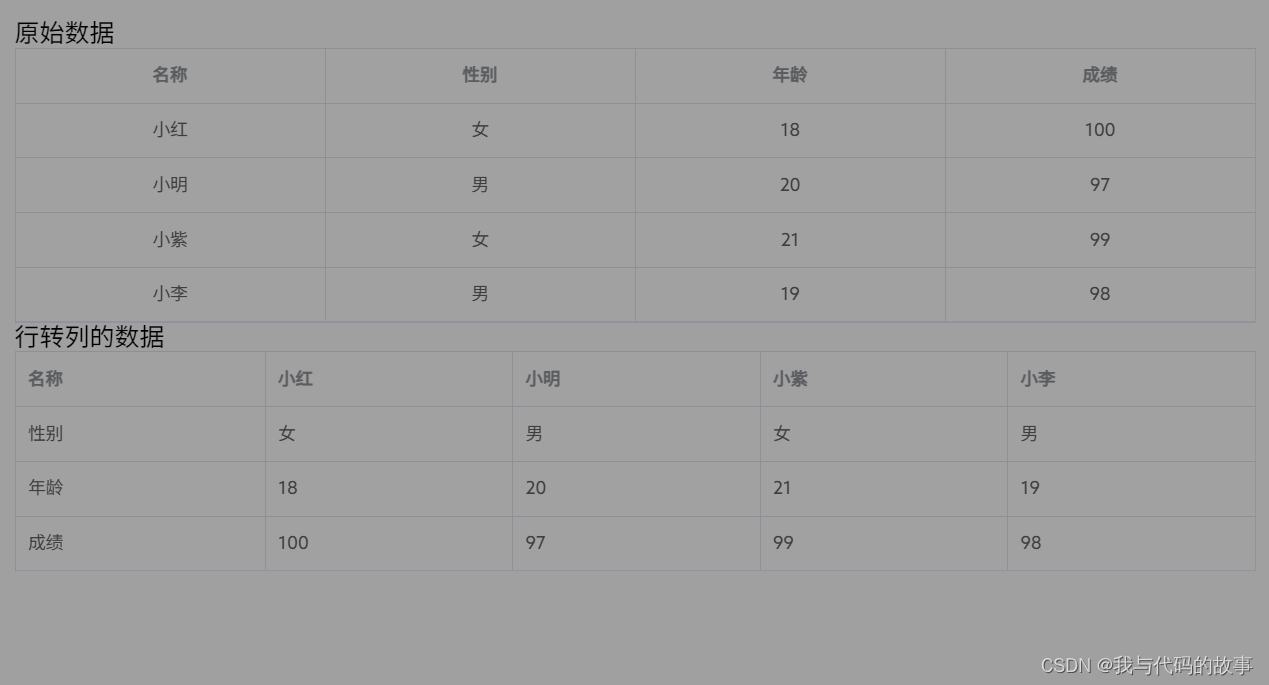el-table实现转置表格
vue版本:vue2.6.10
elementui版本:2.15.14
实现效果:el-table实现行列互换
代码:
<template>
<div class="app-container">
<span>原始数据</span>
<el-table
:data="datas"
border
>
<template v-for="(item, index) in columns">
<el-table-column
:key="index"
:prop="item.prop"
align="center"
:label="item.label"
/>
</template>
</el-table>
<span>行转列的数据</span>
<el-table
:data="tableData"
border
>
<el-table-column v-for="item in columnsData" :key="item.prop" :label="item.label" :prop="item.prop">
<template slot-scope="scope">
{{scope.row[item.prop]}}
</template>
</el-table-column>
</el-table>
</div>
</template>
<script>
export default {
name: 'TestTable',
data() {
return {
datas: [
{
"user_name": "小红",
"user_sex": "女",
"user_age": 18,
"grade": 100
},
{
"user_name": "小明",
"user_sex": "男",
"user_age": 20,
"grade": 97
},
{
"user_name": "小紫",
"user_sex": "女",
"user_age": 21,
"grade": 99
},
{
"user_name": "小李",
"user_sex": "男",
"user_age": 19,
"grade": 98
}
],
columns: [
{ "label": "名称", "prop": "user_name" },
{ "label": "性别", "prop": "user_sex" },
{ "label": "年龄", "prop": "user_age" },
{ "label": "成绩", "prop": "grade" },
],
tableData: [],
columnsData: []
}
},
created() {
this.init()
},
methods: {
init() {
console.log('test')
const _this = this
const columnObj = {} //创建标题数组中第一个对象
columnObj.label = '名称' //第一个标题名称
columnObj.prop = 'title' //第一个标题名称对应的字段
_this.columnsData.push(columnObj) //第一个标题 放入标题数组中
_this.tableData.push({ 'title': '性别' }) //表格数据中第一个对象数据 属性名叫 title 与上面的第一个prop设置一样
_this.tableData.push({ 'title': '年龄' }) //表格数据中第二个对象数据 属性名叫 title 与上面的第一个prop设置一样
_this.tableData.push({ 'title': '成绩' }) //表格数据中第三个对象数据 属性名叫 title 与上面的第一个prop设置一样
var props = 'prop' //自定义字段名称
_this.datas.forEach(function(item, index) {
const columnObj = {}
columnObj.label = item.user_name // 每一列的标题的名称
columnObj.prop = props + index //自定义每一列标题字段名称
_this.columnsData.push(columnObj)
_this.$set(_this.tableData[0], columnObj.prop, item.user_sex) //表格数据中第一个数组对象 往里面添加自定义的属性
_this.$set(_this.tableData[1], columnObj.prop, item['user_age']) //表格数据中第二个数组对象 往里面添加自定义的属性
_this.$set(_this.tableData[2], columnObj.prop, item.grade) //表格数据中第三个数组对象 往里面添加自定义的属性
})
console.log(_this.columnsData)
console.log(_this.tableData)
}
}
}
</script>
界面展示效果:

原文地址:https://blog.csdn.net/xing7290/article/details/136338351
免责声明:本站文章内容转载自网络资源,如本站内容侵犯了原著者的合法权益,可联系本站删除。更多内容请关注自学内容网(zxcms.com)!
